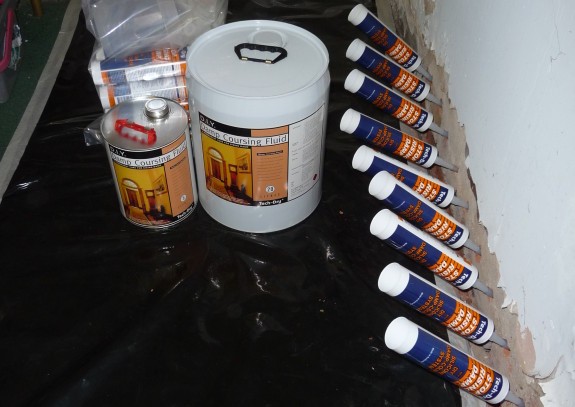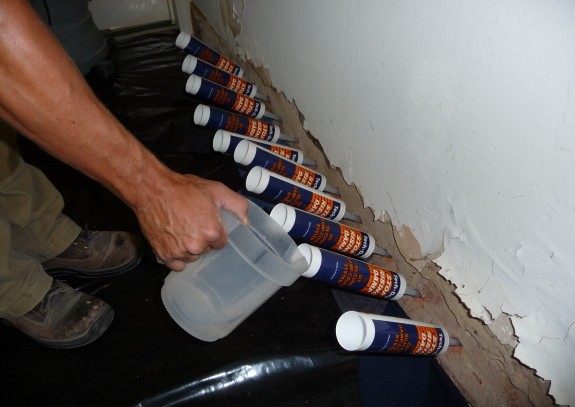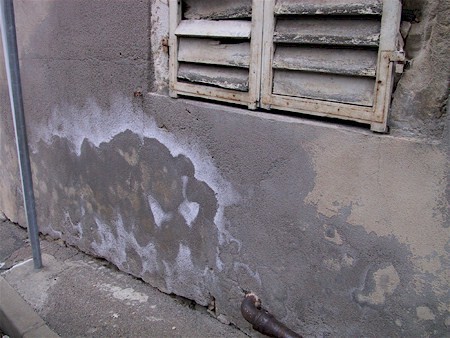- Home
- Products
- Rising Damp Treatment: Fixing Rising Damp
- Damp Course Fluid
Damp Course Fluid
Description
DAMPCOURSING FLUID (DCF) is a silane/siloxane-based impregnant specificallyformulated to permeate into wet walls. Once impregnated into a course of brickwork, DCF reacts with the minerals present to form a durable polysiloxane damp course which permanently stops rising damp. Tech-Dry DCF was developed and tested at the Victoria University of Technology Building Protection Science Unit. It has been used in over 10,000 successful damp course installations Australiawide, both in domestic and commercial properties, as well as some important heritage buildings since 1982.
Recommended Uses
DCF is used to install a durable polymer damp course into brick work or other masonry walls to permanently stop rising damp. Some of the important features of DCF include:DAMPCOURSING FLUID (DCF) is a silane/siloxane-based impregnan
- Penetrates deeply into bricks, mortar and other masonry substrates.
- Forms polysiloxane damp course permanently bonded within the substrates.
- UV, alkali stable and durable formulation.
- Reduces water penetration, salt migration and other water-borne staining.
- Non-dangerous, non-corrosive and non-toxic formulation.
- Easy application and cost effective.
As masonry walls vary significantly, a test MUST be carried out prior to application to find out the suitability of this product for the purpose
Use Instructions
Tech-Dry damp course installation
A Tech-Dry damp course can be installed either commercially by an authorised Tech-Dry technician, or by a simple and easy to use “Do-It-Yourself” method.Contact the Tech-Dry office in your state for commercial installation.
DIY damp course installation procedure
Please read the product information for the correct application and safe handling.The following application instructions are for Do-It-Yourself application. Please refer to a separate booklet called “DIY Damp Coursing Application Instructions” for details.
- 1) Carefully remove any skirting boards present to reveal lowest course of bricks.
- 2) Drill two blind holes in each brick using a sturdy hammer drill, and then fill with DCF using Tech-Dry damp course DIY application kit.
- 3) Once the DCF has saturated the bricks in a complete horizontal layer, the new damp course is installed and the wall above the damp course will begin to dry out.
- 4) Do not splash DCF onto any area you do not wish to treat. If splashing occurs the product should be removed with a cloth damped in a solvent such as mineral turpentine immediately. Equipment can be washed in mineral turpentine.
Drying out of the wall after damp course installation
The new damp course will permanently stop the rising damp. The water which isalready present in the wall above the damp course will start to evaporate out as soon as the damp course is installed. In general, the treated wall should be let to dry for up to 6 months before any necessary rendering or plastering is carried out. We strongly advise to leave the old render or plaster on the wall during this drying period as the old surface finish acts as a poultice and draws out the rising damp salts which are present.
Re-rendering and re-plastering of the wall
Most damp walls are salt affected and the plaster or render will never recover. The salts within the surface tend to absorb moisture from the atmosphere making the render or plaster feel or look wet. It is therefore a waste of time or money patching and painting the old render. The salts will bleed through the new paintwork and destroy the new finish. It is therefore important to re-render or re-plaster the wall as shown below:
- 1. Remove all salt contaminated render and plaster to show bare bricks to a height of 300mm above the last visible signs of dampness.
- 2. The exposed brickwork should be wiped with a damp cloth to remove any residual salts. This should be repeated twice allowing one day between wiping’s. This whole process should then be performed every three weeks until no more salt appears.
- 3. Apply cement/sand render finish containing a salt retarding admixture. An ideal admixture is Tech-Dry SALT RETARDER. The inclusion of this admixture inhibits the migration of residual salts through the new render. Do not extend this render behind the skirting boards, that is, batten the skirting away from the
wall with the top of the skirting meeting the bottom of the plaster. - 4. Apply base coat of render. When set, finish with hard plaster.
- 5. Do not use of plasterboard as this material has very little resistance to residual salts in the walls. But if this is the desired finish, treated pine battens or rubberbased adhesive should be used. Do not use normal cornice adhesive.
DCF consumption rate
The DIY consumption rate of DCF is about 1.5 litres per lineal meter of single brick wall. However, this rate varies significantly depending on the permeability of the substrate and conditions of buildings.
Typical Data
- Appearance: Colorless liquid with hydrocarbon solvent odor
- Solids content: <50% by weight
- Specific Gravity: 0.79g/ml at 20 oC
- pH value: Not allocated
- Solubility in water: Insoluble in water
- VOC content: >50%
- Flash point: >38 oC
Important Note
Due to the variation of building materials, it is strongly recommended that a pilottest on a small area on site should be conducted prior to application to find out the suitability of this product for the purpose. Contact the Tech-Dry office for more information if need.
Handling & Storage
DAMPCOURSING FLUID is a hazardous and flammable material. Refer to thematerial safety data sheet for safe application and handling. Follow good industrial hygiene procedures when using this product. Vapour inhalation and skin or eye contact should be avoided by wearing proper protection. Wear an air-purifying respirator if there is a risk of exposure to high vapour concentrations. Wash hands after handling. The product should be stored in closed containers in a cool dry place away from any fire and ignition sources. The product has a shelf life of 12
months in a sealed original container under 25oC.
Use under sufficient ventilation away from any fire or ignition sources!
Keep out of reach of children!
Packaging:
DAMPCOURSING FLUID is available in 5, 20 and 200 litre metal drums.




